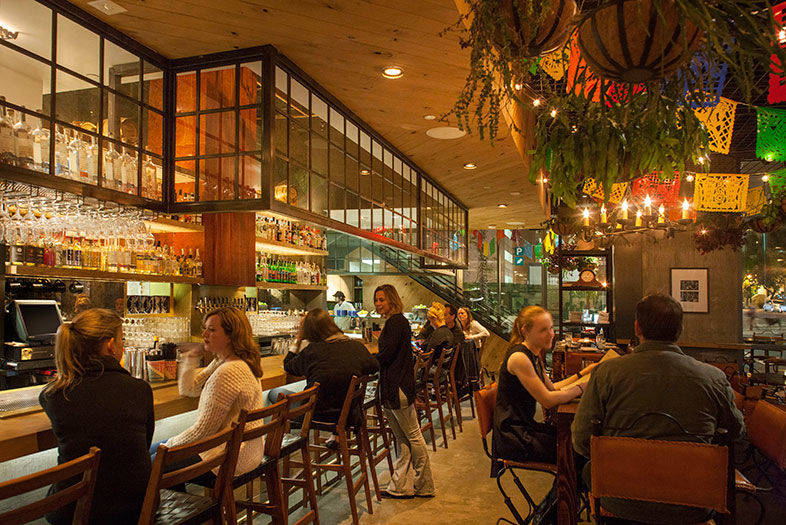Bracero
1490 Kettner Boulevard,
Little Italy
Troy’s Picks
Birria Plate
Carnitas Taco
Carrot Aguachile
Mexican food is tired of our paper bags. Though proud of its street food roots, it’s tired of not being taken seriously in places with actual plates and architecture and art. It doesn’t yearn to be snobby, but its finest chefs can satiate snobs.
In Chicago, Rick Bayless has proven the cuisine worthy of Michelin stars and James Beard’s ghost. Richard Sandoval did the same in New York, and Mary Sue Milliken and Susan Feniger elevated the taco in L.A. And now a handful of chefs have finally done it in San Diego—Javier Plascencia chief among them.
Plascencia was raised in Tijuana, where his family built a restaurant empire (starting, ironically, with pizza joints). When cartel violence made Tijuana too dangerous, he relocated his family to Chula Vista near his restaurant, Romesco. There, he fused Mexican with classical French and other high-end techniques, resulting in dishes like bone marrow sopes with cabernet sauce. In 2011, he opened the modern cuisine showroom Misión 19 in Tijuana. He even bought Caesar’s, the famous Tijuana restaurant where the Caesar salad was invented.
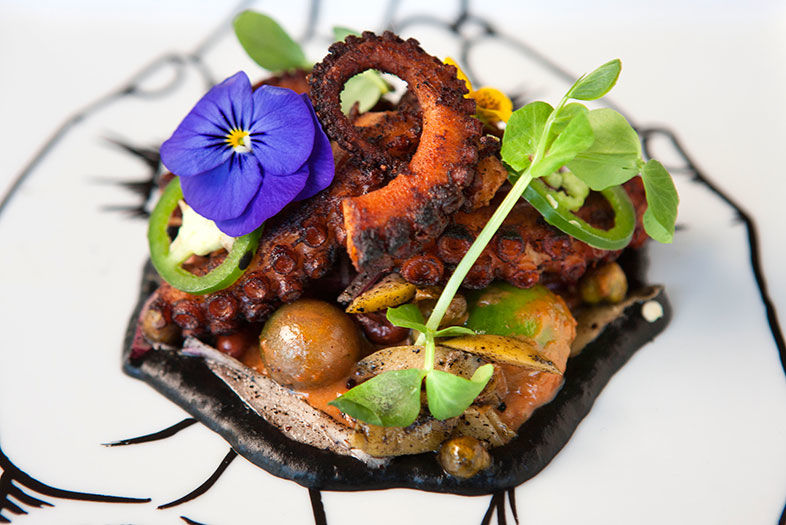
Restaurant Review: Bracero
Small Plato: Wood-grilled octopus with crispy garbanzo and yuzu-roasted peanuts.
Small Plato: Wood-grilled octopus with crispy garbanzo and yuzu-roasted peanuts.
The New Yorker called him the savior of Baja cuisine. Anthony Bourdain hired him as a culinary Sherpa through Tijuana. His hype hit a crescendo. But he lacked one thing—a signature restaurant in the heart of San Diego.
Now he has it. Bracero Cocina de Raiz is in the white-hot culinary hub that is Little Italy. It’s a cozy two-story spot, designed by local firm Bells & Whistles (Starlite, L.A.’s Broken Spanish, etc.). Edged with a seated patio, the interior is all concrete, wood, brass, and glass. Not a soft surface in the joint, which doesn’t make it the quietest place in the world. One wall is painted in two-tone maroon and white, emblazoned with Bracero’s logo. Plants hang. There’s plenty of woven material in the form of baskets and chairs. A huge, vintage farm plow hangs from the ceiling in a sort of art atrium for the main dining room upstairs. There’s a wall of bracero (migrant worker) hats.
The first thing you notice is the giant wooden bar, where one of the city’s best, Christian Siglin, runs things. The drinks are Mexico, now and then, heavy on the tequila and mezcal. Try the excellent Javier Wallbanger, with blanco tequila, Galliano, lemon, orange, vanilla, and allspice dram. Or the Czech Yourself, with mezcal, Becherovka (herbal Czech bitters), falernum, lime, pineapple, orgeat, cinnamon, and absinthe. Wines are mostly from Valle de Guadalupe—Mexico’s Napa Valley, two hours south of the border. The craft beers straddle the border, with Mexico’s Agua Mala and Insurgente next to San Diego’s Alesmith and Modern Times.
In the kitchen, you see a Mexican woman patiently making fresh tortillas. The difference between house-made tortillas and industrial tortillas (whose ingredients are built for long life, not flavor) is the difference between Wonder Bread and a warm baguette. The bartender explains that half the staff lives in Mexico and has worked under Plascencia for years.
The menu is a collection of greatest hits from Plascencia’s restaurants (including the world’s original Caesar salad—delicious, like a museum piece for your mouth), plus new ideas from chef de cuisine Claudette Wilkins.

Restaurant Review: Bracero
SPICY STEW: The Jalisco-style birria plate with olla beans and tortillas.
It’s half street food, half Tijuana penthouse food. The seafood creations pay tribute to Popotla, Baja’s fishing village. Like the Shrimp Green Machine Ceviche Tostada with watercress, avocado, and fresh and pickled onions—a SoCal farmers’ market riff on the dockside Mexican classic. One complaint is that the shrimp is fridge-cold. Most restaurants will toss their cold ceviche to bring the temperature up a bit and release the flavor. But alas, letting it sit for a few minutes works just fine.
The best we taste is the carrot aguachile (a lime-heavy ceviche preparation from Sinaloa) with local tuna, Baja scallops, carrots, ginger, ghost pepper, smoked steelhead roe, and cashews. The tart pickled carrots against the ghost pepper heat and smoky-salty roe is excellent.
Over several visits, I find myself more impressed with the lunch menu. Their birria plate is good enough to have Nancy Reagan start a war against it (do we detect cinnamon?), with house-made tortillas, fresh radishes, onions, cilantro, and olla beans. The slow-braised brisket torta with avocado, demi-glace, tomatoes, and pickled onions should make visiting Subway for lunch a crime worthy of capital punishment. That said, they really need to increase the amount of pickled onions to cut the fat of the meat. The fideo seco (spicy pasta) is also very good, with a rich, floral chili pepper flavor. Nitpicking, I’d like herbs, or acid, or any kind of bright note to offset the fat of the included chicharrones. The Tijuana-style “gringas,” or skirt steak in a flour tortilla quesadilla minus heat or exotic ingredients, is probably so-named because it’s a training wheels Mexican dish for white people. But that doesn’t stop it from being delicious. It’s the Milanesa de la Doña with those refried beans loved with lard, and the nopal salad in chicharrón breading is both creative and inappropriately delicious.
As for the tacos? You really can’t go wrong, especially the slow-braised pork carnitas with chicharrones.
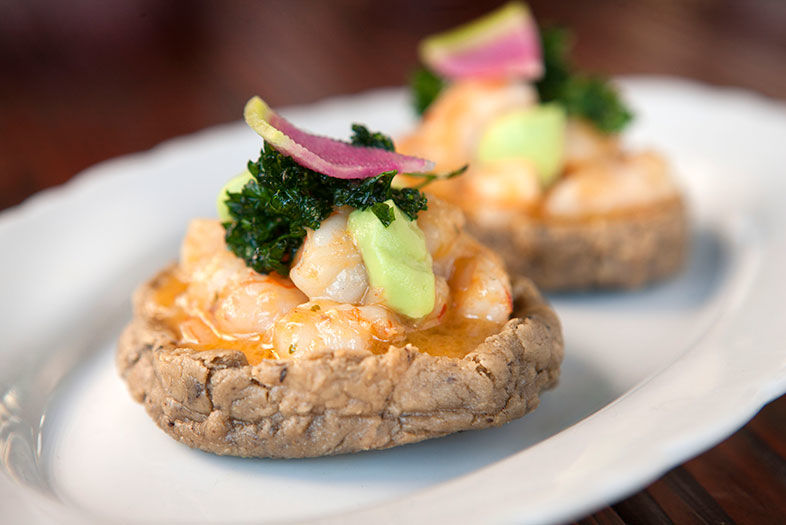
Restaurant Review: Bracero
No bones about it: Shrimp and bone marrow sopes topped with parsley and chile de árbol.
No bones about it: Shrimp and bone marrow sopes topped with parsley and chile de árbol.
From the dinner menu, the wood-grilled octopus comes with Meyer lemon, olives, crispy garbanzo beans, yuzu-roasted peanuts, and jalapeño. With just the right mix of smoke, salt, citrus, and heat, our table loves it. Our token vegetarian also raves about the acorn and kabocha squash in mole negro with toasted hazelnuts and plantain albóndiga (meatball), with the mole’s deep, rich flavor making up for the richness that meat would provide.
Shrimp and bone marrow sopes—a thick round of corn flatbread with marrow, fried parsley, and chile de árbol—get a standing ovation. Hard to go wrong with meat butter on homemade sopes. Also excellent is the albóndigas with crispy brisket and short rib with ayocote beans caldillo (broth), chochoyones (dumplings), avocado leaf, and pickled chayote squash. The squash is the perfect acidic counterpart for what is essentially a Ted Nugent-esque carnivore plate.
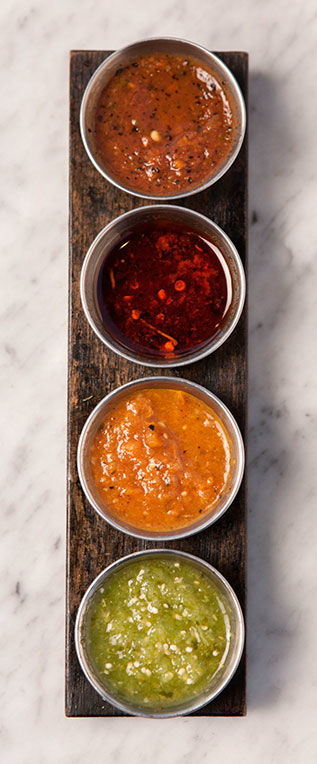
Restaurant Review: Bracero
Heat Wave: The house salsas come in a quartet of flavors, including a top-notch salsa verde
Service at Bracero needs serious work. One night we order raw appetizers, then order entrées 15 minutes later. About 30 minutes into our night, the entrées arrive. We suggest maybe we should get the apps first. The staff attempts to leave the entrées to go find the apps. No, we urge, we’d like those entrées sent back until we’ve had the first part of our meal. An obvious service fail, those entrées should now become staff meals, and the kitchen should cook two new dishes in proper time for our table.
We’re uncertain if they merely kept the entrées under a lamp for a half hour, but those same dishes arrive later a little room-temp. The Corn Masa Crispy Perfect Egg (filled with beef tartare and topped with potato foam) is comically cold. We inform the manager, who apologizes and says she’ll take it off our bill. Later, it’s on our bill. Water glasses go unfilled all night. Service is painfully slow. It is a Saturday, but we’re seated at 5:30 p.m. We’re not here for prime time.
During a second visit, the bartender—though very knowledgeable, prompt, and personable—forgets to serve the house-made salsas. This is a big deal. Bracero has a quartet of excellent salsas, including one of the best salsa verdes I’ve ever tasted, redolent of garlic and incredibly ripe tomatillos. Every single table should always, always get these salsas. Just put them in jars on the table and never take them off. Consider them decor that needs to be placed upon opening every single day. And in bigger serving dishes.
Our desserts, too, underwhelm. A grapefruit panna cotta has far too much rind and zest, puckery to the bone. A jericalla is supposed to be a mix between a flan and a crème brûlée—both renowned for silky, creamy textures. But ours shows up tasting like it’s spent too much time in the walk-in, and the texture is fibrous and rough.
Based on the talent of all involved, I’ve hyped Bracero relentlessly. That doesn’t mean it’s perfect. Still, whether it be the sopes, tacos, birria, torta, octopus, mole, cocktails, or just chips and those salsas, there is excellence. Tighten up the service and hone in the pastries, and all the hype is justified.
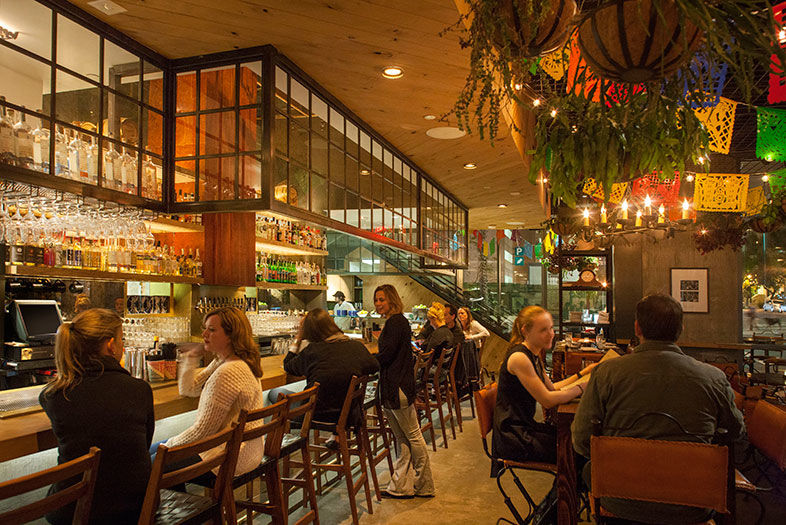
PARTNER CONTENT
Restaurant Review: Bracero









